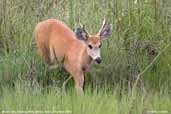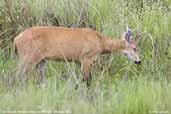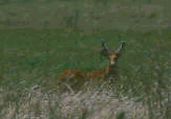
Members of the deer family spread from their original heartlands in Europe and Asia to North America in the early Miocene epoch (about 20 million years ago) and spread into South America in the late Pliocene epoch (about 3 million years ago).

The Marsh Deer is the largest South American deer and, apart from its size, it is noticeable for its rufous chestnut colouring, its large ears with white on the inside and its long, dark legs.

As its name implies, it is found only in marshy areas and prefers water about half a metre deep. To help it graze in the
marshes, its hooves can spread to 10cms across.
There is an illustration in Eisenberg, Plate 19 and some more on-line information at the
University of Michigan
site.

| Previous Page | Back to Index | Next Page |